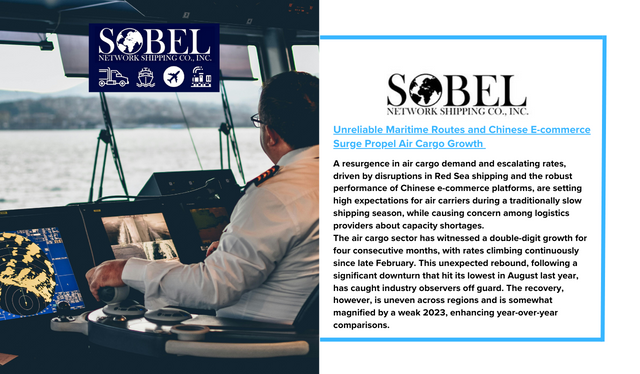A resurgence in air cargo demand and escalating rates, driven by disruptions in Red Sea shipping and the robust performance of Chinese e-commerce platforms, are setting high expectations for air carriers during a traditionally slow shipping season, while causing concern among logistics providers about capacity shortages.
The air cargo sector has witnessed a double-digit growth for four consecutive months, with rates climbing continuously since late February. This unexpected rebound, following a significant downturn that hit its lowest in August last year, has caught industry observers off guard. The recovery, however, is uneven across regions and is somewhat magnified by a weak 2023, enhancing year-over-year comparisons.
Key drivers of this air cargo growth include deteriorating reliability in ocean freight and significant demand from Chinese e-commerce giants like Shein, Temu, and Alibaba, which are exhausting outbound capacities from China. This surge has prompted Taiwan-based logistics firm Dimerco Express to issue a warning in a market update about fully booked airline capacities from China and Hong Kong to U.S. and European destinations for the rest of the year, complicating efforts for freight forwarders to secure consistent shipment space.
Airfreight volumes in March saw an 11% increase year-over-year, according to Xeneta, a rate benchmarking platform. This growth has maintained a consistent 11% rate since January. The International Air Transport Association also reported an 11.9% increase in demand for February, reinforcing Xeneta’s data.
The year began stronger than anticipated, as evidenced by a 6.2% increase in cargo jet flight activity during the first quarter, marking the first positive growth in two years, per BMO Capital Markets research. In March alone, global air cargo sector activity rose by 6.8% compared to the previous year.
With the supply of airfreight lagging behind new sources of demand, the average global airfreight spot rate in March rose by 7% from February. This is a significant recovery from the previous year when rates had plummeted over 40% as the impact of the pandemic waned. The global average spot rate has risen for seven consecutive weeks, now nearly erasing the year-over-year rate disparity, with current shipping prices at about $2.55/kg, 40% above pre-COVID levels.
Niall van de Wouw, Xeneta’s Chief Airfreight Officer, remarked on the robust demand seen in the first quarter, indicating a market still full of potential.
The most significant traffic is on trade routes from the Middle East and Southeast Asia to Europe, as well as from China to Europe and the United States. These strong corridors are lifting the overall global performance, almost pushing United Airlines into growth territory during the first quarter, with revenues down only 1.8% year-over-year after a 31% contraction in 2023.
Red Sea Concerns
Some companies reliant on stable supply chains are now opting for air transport to circumvent Red Sea shipping delays caused by Houthi rebel missile and drone attacks. These attacks have compelled vessel operators to avoid the Red Sea, adding over 10 days to transit times. Schedule reliability on the Asia-to-Northern Europe route plunged to 34% in February, as reported by Sea-Intelligence. Flexport highlighted that the ocean journey from China to Northern Europe now averages 70 days from factory to port departure.
Demand has started to taper off, with production and distribution post-China’s Lunar New Year no longer driving urgent shipping needs. Moreover, container lines have adjusted their networks to avoid the Suez Canal, opting for routes around Africa which have become more stable due to added carrier capacity to accommodate longer transit times.
Xeneta’s latest figures show a slowdown to an 8% year-over-year growth rate in air cargo demand as of mid-April. The potential for regional conflicts, like the recent Iranian aerial attacks on Israel and seizure of an Israeli-owned vessel in the Persian Gulf, poses additional risks that could disrupt shipping lanes and necessitate air diversions.
As the first quarter concluded, demand continued to outstrip capacity growth, pushing rates upward and improving load factors by two points to 61%. However, these patterns are starting to shift as April has seen an approximately 11% increase in supply over the previous year. An influx of aircraft from passenger airlines during the summer travel season is expected to further augment cargo capacity, although high passenger and baggage loads could limit space for cargo.
Despite these adjustments, capacity remains tight on trans-Pacific routes due to incomplete network recoveries by Asian carriers, exacerbated by a diplomatic rift between the U.S. and China. The slow reinstatement of flight permits for Chinese airlines by U.S. authorities—only recently increased to 50 weekly flights—reflects a fraction of pre-pandemic activity levels.
In response, some airlines are introducing more freighters in Asia to capitalize on the robust market. CMA CGM Air Cargo announced plans to commence operations with a new Boeing 777 cargo jet between Hong Kong, Chicago, and Seoul in the latter half of the year, with a second 777 expected to enter service later to connect China with North America.
Overall, the air cargo industry remains optimistic about maintaining solid volume growth throughout the year, even if the current high performance levels off. This outlook is supported by global economic indicators that, while mixed, suggest conditions conducive to continued air cargo expansion.


